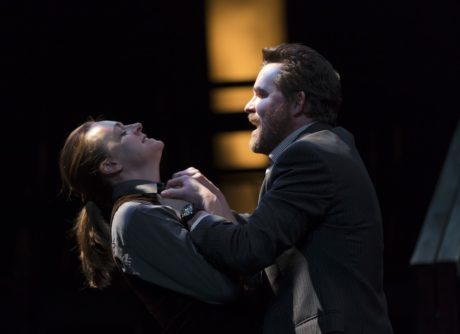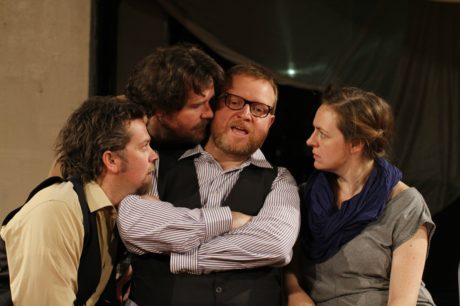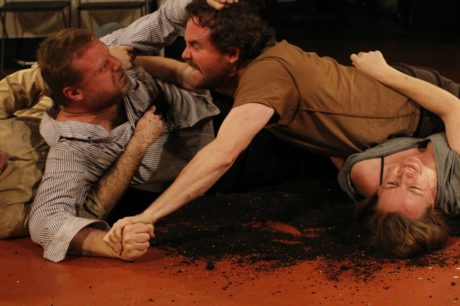There’s nothing extravagant about the two shows playing at the McCarter Theatre. Both are presented on a stage stripped to its bare essentials: we can see all the way back to the building’s rear wall. There’s little in the way of scenery or props. There’s nobody credited as costume designer – the actors mostly wear modern, casual clothes. And there’s no electronic amplification; the actors project their voices so strongly that none is needed.
Just about all we have to concentrate on is the acting. And the words. And they remind us that if the text is great and the acting is great, nothing else really matters.

Bedlam, a New York-based acting company, is at McCarter performing Shakespeare’s Hamlet and Shaw’s Saint Joan in “rotating repertory.” That means that the same cast is performing these shows on alternating nights. That in itself is a herculean task – each play runs about three hours and is stuffed with difficult language – but what makes it even more extraordinary is that the cast has only four members. And they play all the characters in both plays – dozens of characters altogether.
Miraculously, they not only pull it off without a hitch, they also provide keen insights into the characters and give the plays an exceptional freshness and vitality.
Hamlet and Saint Joan are epic works, but Bedlam stages them with a quirky intimacy. About seventy audience members are sitting on chairs onstage, with the actors moving around among them. (People who bought seats in the first three rows are given these onstage seats, and the actors invite other audience members to sit in any empty seats.) Each play has two intermissions, and during those intermissions, the onstage seating is completely reconfigured – chairs are moved from the floor to bleachers or vice versa, the bleachers are moved from the rear to the side, etc. It’s just one way that Bedlam gives its audience a new perspective on the classics.
So, how do they do these plays with just four actors? The actors change rapidly before our eyes using subtle changes in attitude, voice, gesture, and posture. For instance, in Saint Joan, a soldier wearing a wool cap marches in to announce that a bishop is about to enter; then the same actor pulls off his cap, turns around 180 degrees, and adopts a different accent. Voilà, he’s a bishop. In Hamlet, we see two seated actors leaning forward and slanting their bodies to one side, concentrating hard to catch every word of the conversation. These are the obsequious messengers Rosencrantz and Guildenstern. And whenever we see any two actors strike that same eager-to-impress pose, the audience instantly knows that Rosencrantz and Guildenstern are back.
Do these lightning-quick transformations ever get confusing? Well, there was only one moment in either play when I felt at sea. It came in the second scene of Saint Joan – a scene that involves a group of characters we haven’t been introduced to yet. The actors moved so quickly between those characters – at times standing on metal chairs to signal their shift to another personality – that the effect was a bit dizzying. But for the rest of the plays, everything was clear, with well-defined changes.

The plays have been given sparse, efficient stagings. And while the shows are far from luxurious, director Eric Tucker does add a few theatrical flourishes to amplify the meaning of the text. For instance, when Hamlet speaks to the ghost of his father, he does it in near-total darkness, with the voice of the ghost being provided by the other three actors in different areas of the theatre. Somewhere out in the pitch black void, one of the actors is speaking the lines – or sometimes two actors at once, or sometimes three at once. It gives the scene a spooky, unsettling air.
And when the ghost departs, and Hamlet stands alone on a platform and launches into a soliloquy, one of the other actors stands on the floor below him holding a flashlight. That flashlight provides the only illumination Shakespeare’s words need. (Lighting designer Les Dickert does tremendously varied work here, while set designer John McDermott uses a rough-hewn scaffold and some judiciously-placed drop cloths to evoke grandiose settings.)
Tucker plays Hamlet, and he does it with an intriguing mixture of rumination, anger and timidity. When King Claudius finds Hamlet hiding out (in one of the auditorium seats) and drags him down to the stage, Hamlet keeps his head down and mutters “Oh no.” He may be the central character, but he doesn’t always want to be the focus of attention.
Andrus Nichols, the troupe’s only female member, plays Joan of Arc with an ennobling intensity. Her energy and eagerness in the early scenes of Saint Joan – she makes her entrances running quickly while wearing sneakers – give her a peculiar charm. Her direct, forthright manner of speaking is perfect for the role, giving Joan a candor that endears her to her followers. (You can easily imagine her leading an army.) And as the play progresses and the tragedy intensifies, and the allegiances of all those around her shift with every breeze, Nichols’ solemn certainty shines through at every moment.

The other two ensemble members, Edmund Lewis and Tom O’Keefe, have a versatility and authority that give power to their roles. And what roles they are! Lewis’ roles include Polonius, Laertes and Horatio in Hamlet, as well as the Chaplain and the Dauphin-turned-King in Saint Joan. O’Keefe plays King Claudius and the Gravedigger in Hamlet, and the Bishop Cauchon in Saint Joan, among many other characters. Nichols plays Ophelia and Gertrude in Hamlet, plus a gender-switched Player King. And Tucker’s roles in Saint Joan include a vengeful archbishop and the urbane Earl of Warwick. (Stage Manager Diane Healy pops up from time to time to say a few lines or help with the scene transitions.)
There’s a joyousness to the ferocity with which the actors tackle their roles. Tucker’s direction brings out the humor in these plays, especially in Saint Joan, which mixes deadly serious drama with scenes that have the light touch of Shaw’s drawing room comedies. And by presenting these plays together, Bedlam contrasts different types of protagonists and different themes: female vs. male, action vs. inaction, assurance vs. uncertainty.
Seeing both of these plays requires dedication and concentration – not to mention more than six hours of your time. If you can only make it to one show, which should you choose? I found Hamlet the better production, yet I thought the best performance was Nichols’ turn in Saint Joan. But if you can make it to both shows, do so. Bedlam’s spare, focused and engrossing approach to these two classics makes for an all-encompassing theatrical experience that will remain with you for a long time. I guarantee you’ve never seen anything like it.
Running Time for Hamlet: Three hours and ten minutes, with two intermissions.
Running Time for Saint Joan: Three hours, with two intermissions.

Bedlam: Hamlet and Saint Joan play in rotating repertory through February 12, 2017 at the Berlind Theatre at McCarter Theatre Center – 91 University Place in Princeton, NJ. For tickets call (609) 258-2787, or purchase them online.




